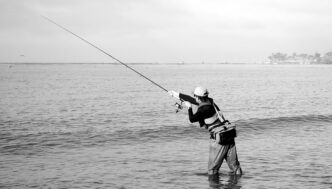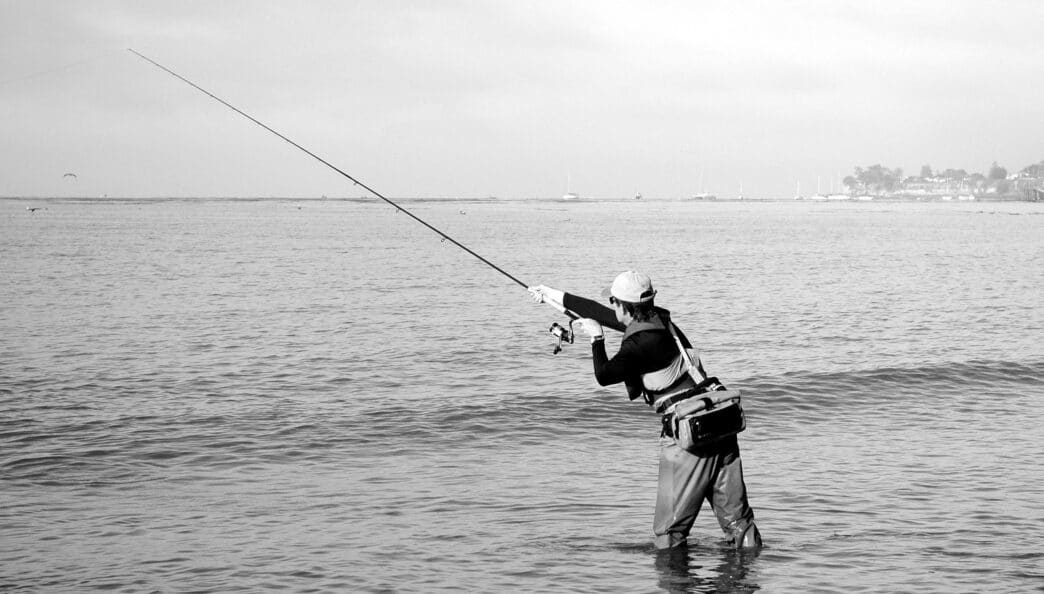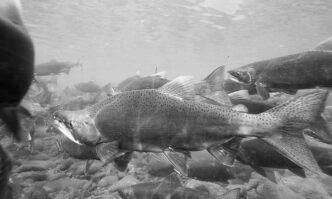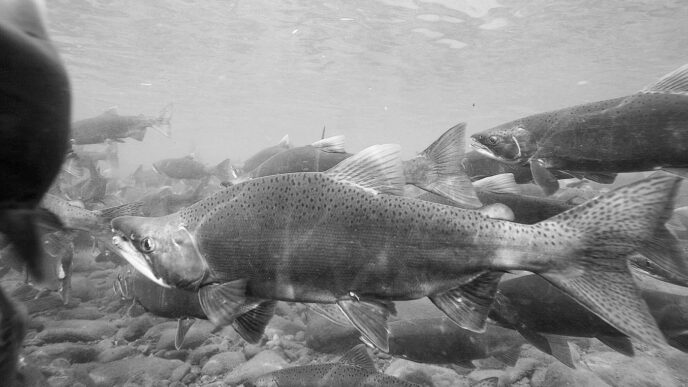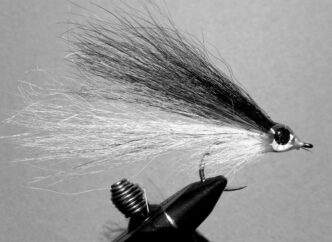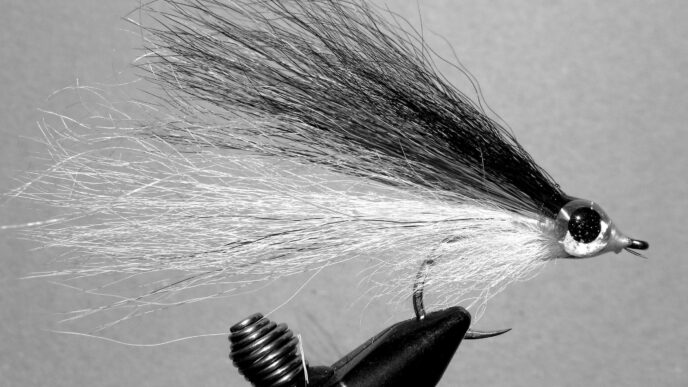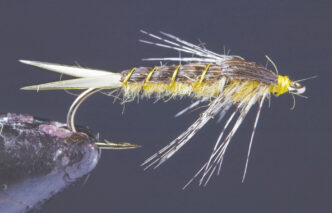A couple of years back, a tackle manufacturer’s advertisement featured the following quote: “Everybody says distance doesn’t matter. It doesn’t . . . until it does.” This simple statement is certainly true in the surf. While there are times when a 45-foot cast will put your fly in front of hungry fish, there are also times when a cast of twice that length will still come up short. Even for those who can cast 90 feet or more, there is still the problem of what to do with all that line when you retrieve it. For anyone casting into the triple digits, line management becomes a major headache. So you can imagine the kind of migraines I was risking as I set myself a target of casting a fly 120 feet over the waves. That would mean not only trying to figure out how to cast beyond my limits, but also having to manage over 100 feet of shooting/running line. Why would a sane person decide to do such a thing?
Striper Envy
Anyone fishing the surf from Marin to Monterey will frequently see conventional-tackle anglers casting jigs, metal lures, and pencil poppers in search of big stripers. The pros at this sport methodically work their lures down the middle of big, boiling rips, along the far edges of wave-pounded flats, and through deep, dark cuts in offshore sandbars. The folks working pencil poppers seem to have the most fun. These chunky lures look like surface-to-air missiles as they arc out over the surf. As soon as they have landed, the angler chugs them back across the surface by quickly snapping the rod tip and reeling in at the same time. Every so often, a striper will appear out of nowhere to attack the lure. The fish will frequently slash wildly at it, sometimes throwing the lure airborne in a savage display of carnivorous rage. It is a truly wonderful spectacle.
For most fly fishers, the ability to cover the bigger rips and cuts in offshore bars effectively is really an option for only about an hour or so on either side of the low tide. Even then, getting the fly in position can require aggressive wading and casts of 80-plus feet. Believe me, this is much easier said than done. More times than not, the fish won’t move into these waters until the flooding tide has added a few feet of depth and generated strong hydraulics. By then, you have usually been forced another 20 to 30 feet up the beach, effectively putting the striper hot zone out of reach. The ability to cast stripersized flies 120 feet would add about another hour or so in the hot zone. The question nagging away at me has been How on earth do you consistently heave a big fly out that far using a fly line and a fly rod?
Spinning in Circles
During the spring of 2009, I was working on a new stripping basket design. I wanted to address the problem of line tangles, which are a headache for anyone using these contraptions in the suds. I was focused on the thorny problem of the optimal way for line to lie inside the basket. I figured that laying the line in a series of circles, in a way similar to what is done with a spinning reel, might be a good solution. While working on a prototype basket, it occurred to me that actually using a spinning reel on a fly rod might be a neat solution to the tangle problem. I put the basket project to one side and started digging around in some old tackle boxes for a spinning reel.
Heresy?
Let’s face it. Deciding to use a spinning reel to fly fish is getting pretty close to fly-fishing heresy. Some might say it crosses the line. Whatever. I wanted to see what I could do with this setup and decided to explore it further. Besides, what’s the worst that could happen? I had already sold my soul to the Devil by using indicators to catch halibut.
In a dusty corner of the garage, I found an old 1960s-era DAM spinning reel. It was still in the original box, which proudly proclaimed “Product of West Berlin.” Happily, the reel was in good working condition. The next problem was figuring out what fly line to use. The size of the reel pretty much solved this problem. There was no way it had the capacity to handle a full fly line. It was clear the solution was the venerable combination of a shooting head and mono shooting line.
Now I had to figure out which fly rod I was going to use. I had a hunch that casting a typical single-hander with a spinning reel would probably not be ideal. This was quickly confirmed at the local playing field with a 9-weight rod and a 320-grain shooting head. Casting the setup without a double haul was OK, but lacked any real distance. When I tried to incorporate hauls, I found myself pulling mono off the spool (against the drag) or having loose line wrap itself around the reel. Not surprisingly, both of these problems totally screwed up the cast.
Shock and Awe
After the disappointing single-handed rod test, I went home and dug out a medium-fast-action 11-foot 6-inch 8-weight double-hander. Rummaging around in my shooting-head box, I found 30 feet of T-17 tungsten shooting head. I had nicknamed this line Robespierre after it had tried removing my head during an unsuccessful rockfish trip. I knotted Robespierre onto the spinning reel’s monofilament and returned to the field. For my first cast, I let out enough mono to create about three feet of overhang. I trapped the mono from the reel against the lower grip using my left index finger. I swung the rod around using the Belgian-style casting stroke I normally use for dense, heavy heads. Not surprisingly, because I was unfamiliar with the feel of the gear, the resulting cast was less than fluid. Robespierre and the large fluff fly flew out in a really ugly mess. As I watched the goober of line and fluff drop to the ground I thought to myself, “This might be another great idea heading for the crapper of reality.” Then I saw where the fly had landed. To my complete surprise, it was almost 100 feet away. How often do you totally flub a cast and still have 33 yards between you and the fly? It dawned on me that I might actually pull this off. A few casts later, I started to get the rig dialed in. It was then that the distance potential of the rig became evident. Most casts went out 120 to 130 feet with absolutely no sweat. Within the hour, I was hitting 130 feet consistently, with some casts nudging 140 feet. I made plans to drag the rig to the suds the next day.
On the Waterfront
I arrived at a quiet local beach at 7:00 A.M., armed with the rod, reel, and Robespierre. I tied a 1/0 Deceiver pattern onto a short leader and walked to the edge of the water. The large swells made roll casting a bit of problem, so it took some effort to get the line and fly off the water. However, once the line and fly were airborne, things were pretty much the same as at the field. With a couple of feet of overhang and a simple casting stroke, the fly went out about 110 feet. As I got more comfortable with the rig, the distance crept up steadily. After 30 minutes, I was throwing the fly out about 120 feet with no real sweat. I did not land any fish that day, but I left the beach with a grin so wide it almost hurt.
Refinements
I have fished this setup over the past few months and have made a few improvements for the surf. Perhaps the most significant change is that I now use 50-pound-test super braid as a shooting line. The thin diameter, high flexibility, and light weight of these lines makes them absolute pigs on normal fly-fishing setups. They tangle very easily, and the resulting knots can be a nightmare to pick apart. No one I know has figured out how to use them reliably as shooting lines. On a spinning reel, however, these problems disappear. In countless hours of casting, I have had only three small tangles. All of these occurred during test casting at the field and were the result of me not keeping a small amount of tension on the line as I reeled it back in. I have had absolutely no tangles on the beach, which is something I could never claim when using conventional fly gear.
There are three distinct advantages to using super braid as a shooting line. It has virtually no stretch, which means you have almost direct connection to your fly. Even gentle, plucking takes are felt sharply through the line. The thin diameter of the braid reduces the effects of currents and breaking waves on the line, making it easier to work the fly more effectively in rough water. And last, but certainly not least, using braid adds about 10 feet to my casts when compared to 20-pound mono. The only downside that I have found to using braid is that it tends to cut into wet fingers. You really need to wear a strip-ping finger guard when using the stuff.
It is not necessary to fill the entire spool with super braid. I use only 225 feet of braid on my reel and simply fill the rest of the spool with mono for backing (which is cheaper than dacron). This means a 150-yard spool of super braid that costs about $15 provides two shooting lines. That’s quite a deal.
One thing that helps with distance is ensuring the line lies evenly on the spool. Very few spinning reels lay line down on the spool in a perfectly smooth pattern. Typically, they lay too much at the front or back of the spool, which creates a lumpy profile. To solve this problem, simply load the reel to within a sixteenth of an inch of the top lip of the spool and note where high and low spots occur. Make a drawing if necessary. Now strip off about 50 percent of the braid and underlying mono. Using only your hands, wind line firmly onto the reel so you reverse the pattern of bumps and hollows. In other words, where the line created a hollow before, you create a similar size bump. I find this usually takes about 30 to 100 feet of line. Once you have created the inverse pattern, simply flip the bail over and reel the rest of the line onto the spool under even tension. You should end up with the line having a flat profile from front to back.
You may be wondering if you can use a Spey rod with this setup. Indeed you can. I have used this setup on my 14-foot 9-weight Spey rod. Matched with a 550grain sinking head, this rod is able to churn out 150-foot casts on grass. Several casts have even nudged 160 feet! However, the great results on grass did not translate into longer casts at the beach. In the real world, distances were the same as I achieved with my shorter, faster doublehander. The reason is that unless the beach behind you is flat, you can’t really use the full casting arc needed by the slower action of a Spey rod. I am guessing the ideal rod for this setup would be a fast-action 15-foot 9/10-weight. Such a rod loaded with a 600-grain line and 30-pound braid would probably have the power to make fishing distances of 140-plus feet a realistic objective. Needless to say, I am now trying to figure out how to convince my wife that I need yet another rod.
Suitable Shooting Heads
Thanks to significant line development for double-handed rods in the past few years, there is a reasonable selection of shooting heads suitable for this application. Scandi and Skagit heads are an obvious choice. They were designed to fish on these rods and come in floating, intermediate, and sinking densities. For doublehanders in the 7-to-9-weight range, heads from 400 to 550 grains should be ideal. While it is possible to cast a 38-foot Scandi head on this rig, it can be a handful. I find Scandi heads in the 30-to-33-foot range are much more user friendly and don’t seem to result in a significant reduction in distance. Of course, the practical solution for fast-sinking heads is T-14 or T-17 line. Thirty-two feet of T-14 will make a 450-grain head. Thirty feet of T-17 will get you a 510-grain head. While these heads lack the smooth flight characteristics of Scandi heads, they still go a very long way.
Hooking and Landing Fish
Although I have yet to hook a giant striper on this rig, I have caught a goodly number of fish. Some were hooked at the far end of the cast, proving that it is quite possible to cast 120 feet and still strike effectively. Fighting fish is actually easier than it is with a normal fly reel. The drag on the spinning reel can be set to yield line smoothly when a fish runs. The fast retrieve of the reel makes it much easier to stay in contact with any fish that decides to head inshore at a fast clip.
Beaching fish on this rig provides a bit of an extra challenge. You cannot simply reel the shooting head back onto your reel, as you would with a conventional flyrod setup. Having fly line on a spinning reel is courting disaster. If the fish takes off, the line may jam in the reel. That is a sure-fire way to lose the fish. Instead, stop winding just before the head reaches the reel. This will leave anywhere from 16 to 27 feet outside the tip, depending on the length of your rod and the length of the shooting head. All you do then is simply walk backward, gently beaching the fish.
Just Another Tool
While I suppose you could use this rig for all of your surf fly-fishing needs, it is not really the best setup for smaller fish or when long casts are not needed. A standard single-hander or even a switch rod setup is much more practical in those conditions. However, when you start to see hardware guys pulling in big fish on big lures, it’s time to think seriously about putting away your normal fly gear. Grab your extreme distance rig and join in the fun.



